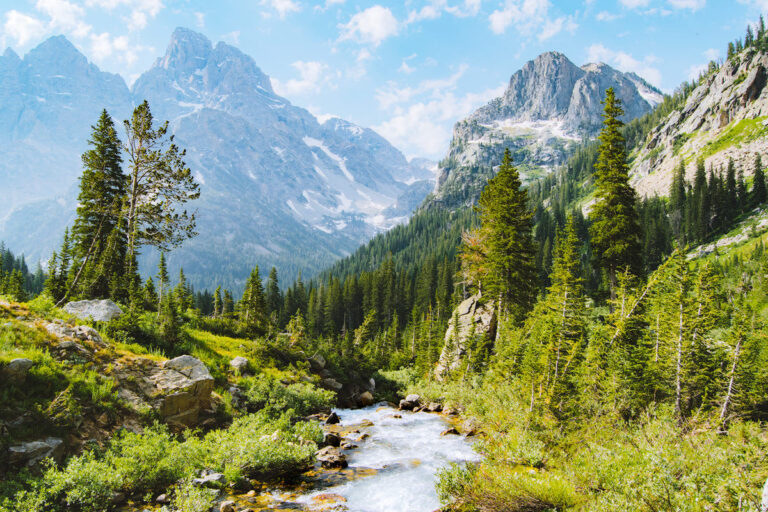The majestic Grand Teton National Park, with its snow-capped peaks, pristine lakes, and abundant wildlife, beckons adventure seekers and scenery enthusiasts alike. But before you pack your hiking boots and camera, consider this: not every season paints the Tetons in the same idyllic light. To ensure your Grand Teton experience is truly grand, knowing the worst times to visit is just as important as planning the perfect itinerary.
The Arctic Apathy of Winter: November to April
While winter transforms the Tetons into a wonderland of snowy landscapes, it’s also the park’s hibernation season. Prepare for bone-chilling temperatures, with lows dipping into the single digits. Most park facilities, including roads, campgrounds, and visitor centers, shut down for the season, leaving you with limited options for exploration and amenities.
Sure, die-hard winter enthusiasts might revel in the chance for cross-country skiing, snowshoeing, or ice climbing. However, be prepared for limited access, extreme weather conditions, and a ghost town atmosphere. Unless you’re a snow bunny with a thirst for solitude, winter is best experienced from afar, admiring the snow-dusted peaks from the warmth of your living room.
Shoulder Season Blues: May and October
May and October might seem like ideal alternatives to the summer crowds, offering glimpses of the Tetons’ beauty without the peak-season frenzy. However, this “shoulder season” comes with its own set of challenges.
May: Spring arrives late in the Tetons, with lingering snowmelt and unpredictable weather. Some trails might be muddy or inaccessible, and mosquitoes, emboldened by the thawing waters, can turn a peaceful hike into a swat-fest. Additionally, many park amenities haven’t fully opened for the season, leaving you with fewer options for lodging and activities.
October: Autumn paints the Tetons in vibrant hues, but the beauty comes with a price. Days shorten dramatically, and temperatures can plummet, bringing the threat of early snow and road closures. Like May, some park facilities start winding down for the winter, offering a bittersweet farewell to the summer season.
If you’re considering a shoulder-season visit, pack for unpredictable weather and be prepared for limited access to amenities. Patience and flexibility are key, as weather conditions can dictate your daily plans.
Summer Stardom, Mosquito Swarms: June to August
The undisputed peak season in Grand Teton National Park, June to August, boasts glorious sunshine, warm temperatures, and access to all the park’s offerings. But with this popularity comes a hefty price tag: crowds. Brace yourself for traffic jams, overflowing campgrounds, and packed trails, especially around iconic spots like Jenny Lake and Inspiration Point.
The summer months also unleash the Tetons’ notorious mosquito population. Prepare to be swatting and slathering on repellent constantly, turning your idyllic picnic into a battleground against these pesky insects.
If summer is your only option, book your accommodations and campsites well in advance, arrive early for popular hikes, and embrace the bustling atmosphere. Consider exploring lesser-known trails or venturing further afield to escape the crowds. And don’t forget your mosquito net!
Beyond the Seasons: Cultural Crossroads and Nearby Delights
While the Grand Teton National Park is the star attraction, its surrounding region offers a wealth of cultural experiences and additional adventures.
-
Jackson Hole: This charming town boasts a vibrant art scene, world-class dining, and a Western flair. Explore the Jackson Hole Art Museum, catch a performance at the Center for the Arts, or sample local brews at one of the many breweries.
-
Yellowstone National Park: A short drive away lies Yellowstone, a wonderland of geysers, hot springs, and geothermal wonders. Combine your Grand Teton adventure with a trip to Yellowstone for an unforgettable double dose of natural beauty.
-
Teton Village: Nestled at the base of the mountains, Teton Village offers a variety of lodging options, from luxurious resorts to cozy cabins. In the summer, enjoy gondola rides, scenic hikes, and wildlife viewing. Winter transforms the village into a skier’s paradise with world-class slopes and après-ski fun.
No matter the season, Grand Teton National Park offers a unique blend of natural splendor and cultural experiences. By understanding the worst times to visit and planning accordingly, you can ensure your Teton adventure is one for the memory books, minus the crowds, mosquitoes, and winter blues.
